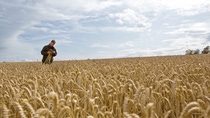Média
The chemistry of cooking

Science writer Harold McGee, PhD, has dedicated his life to finding out what really happens to bread when it bakes, to meat when it hangs or to egg proteins when we whisk them. His journey has led to surprising discoveries and a body of work that has inspired some of the world’s greatest chefs.
Creating Chemistry: Which food myth are you most proud of debunking?
Harold McGee: Recently I put to the test the idea that you have to cook pasta in a large amount of water. I live in California where there is a water shortage and where we are worried about using more energy than we need to. It turns out that you can cook pasta in minimal amounts of water – around 1.5 quarts (1.4 liters) instead of 4 to 6 quarts (3.8 to 5.7 liters) – starting with cold rather than boiling water and it tastes the same. It works because noodles absorb water only very slowly at temperatures much below the boil, so little happens in the few minutes it takes for the water to heat up. And no matter how starchy the cooking water is, the solid noodle surfaces themselves are starchier, and will be sticky until they’re lubricated by sauce or oil. Given how much pasta is cooked a year, this would save lots of water and hundreds of thousands of barrels of oil a year, too.
Why did food science in the 20th century get so side tracked into the food industry?
It’s not that science got side tracked, it just got absorbed into modern movements that were more pressing and larger scale than what happens in homes and restaurants. Around the turn of the 19th to 20th century there were problems with canning – understanding why some cans exploded on store shelves was urgent. Then there was the Spanish American War and World War One, and the need to supply food to troops. Laws were introduced to monitor food safety. It meant scientific talent was drawn into manufacturing. A more relaxed view of what scientific understanding could contribute to domestic and restaurant cooking had to wait.
What made molecular cuisine so attractive in the last decade?
With the opening up of the world, national cuisines have become much less important than they used to be. These days, if you are an ambitious chef who wants to make a name for yourself you need to be inventive. That is where science has been particularly interesting to chefs at the cutting edge – they realize it is a wonderful partner in the search for new ways of doing things. If you understand the basic principles then you can come up with variations on dishes and even completely new ideas that you would not even think of if you were just following recipes from generations ago. For example, chefs have worked with liquid sauces and solid gels like aspic for centuries, but Heston Blumenthal learned about “fluid gels” that flow when poured but become solid at rest. He used that idea to create a cup of tea in which one portion of the tea is hot and a second portion is iced – with no barrier between them.

How important to you is the exploration of different cultural approaches to food?
My focus is on what is possible to do with natural ingredients and their transformation by physical and chemical manipulation. The laws of physics and chemistry are the same no matter what country you live in. That is not to diminish the importance or interest of cultural differences, but I try to find commonalities that all cultures depend on and make use of in their own ways. For example, the sodium and chloride ions in salt bind water molecules to themselves when salt dissolves, and cultures all over the world have used that property to preserve foods by removing their moisture and the moisture of microbes that would spoil them.
What advice do you have for novice cooks and what is the scientific explanation for that advice?
My top tip is to buy a good digital thermometer and be sure to use it when you cook meats, fish, and eggs, all protein-rich foods whose texture is determined by the extent to which the proteins are unfolded and bonded together by heat. In the critical range between 50 and 70 degrees Celsius, every degree or two can make a difference.
Has your scientific approach to food changed your enjoyment of food?
I don’t chew food with a frown but I do appreciate the complexity of the raw materials and the skill it takes to transform them into delicious food with every bite.
